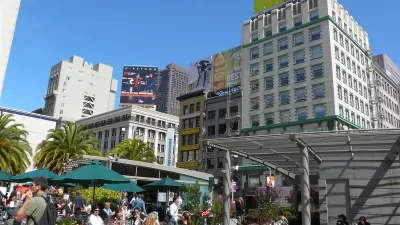Diversity is important to neighborhood commercial areas, but getting the right balance of retail and restaurants without disincentivizing the former is not so simple.
"Restaurants, especially those allowed to serve alcohol, can afford higher rents than neighborhood-serving businesses, like grocery stores, hardware stores, pharmacies and dry cleaners. As bars and restaurants become successful, an area draws more foot traffic, attracting more of those businesses. Landlords can charge higher rent, which pushes out the local businesses. This is basically an economic game theory problem: the most natural equilibrium states are a mostly-vacant corridor on the one hand, and nothing but bars on the other.
Can zoning or other regulations help keep corridors in more of a balance? Is that desirable? One options is to allow market forces to determine the retail mix. But many residents are concerned about their neighborhoods becoming "another Adams Morgan." At the same time, regulation also hampers business, leading to more vacant storefronts. Is there a way to strike a balance, encouraging free enterprise while also maintaining some diversity of store types? "
FULL STORY: Balancing neighborhood retail, part 1: The 25% rule

Alabama: Trump Terminates Settlements for Black Communities Harmed By Raw Sewage
Trump deemed the landmark civil rights agreement “illegal DEI and environmental justice policy.”

Study: Maui’s Plan to Convert Vacation Rentals to Long-Term Housing Could Cause Nearly $1 Billion Economic Loss
The plan would reduce visitor accommodation by 25% resulting in 1,900 jobs lost.

Planetizen Federal Action Tracker
A weekly monitor of how Trump’s orders and actions are impacting planners and planning in America.

Wind Energy on the Rise Despite Federal Policy Reversal
The Trump administration is revoking federal support for renewable energy, but demand for new projects continues unabated.

Passengers Flock to Caltrain After Electrification
The new electric trains are running faster and more reliably, leading to strong ridership growth on the Bay Area rail system.

Texas Churches Rally Behind ‘Yes in God’s Back Yard’ Legislation
Religious leaders want the state to reduce zoning regulations to streamline leasing church-owned land to housing developers.
Urban Design for Planners 1: Software Tools
This six-course series explores essential urban design concepts using open source software and equips planners with the tools they need to participate fully in the urban design process.
Planning for Universal Design
Learn the tools for implementing Universal Design in planning regulations.
Caltrans
Smith Gee Studio
Institute for Housing and Urban Development Studies (IHS)
City of Grandview
Harvard GSD Executive Education
Toledo-Lucas County Plan Commissions
Salt Lake City
NYU Wagner Graduate School of Public Service




























